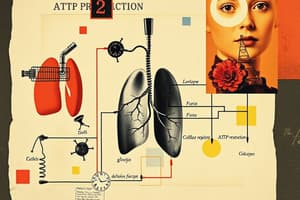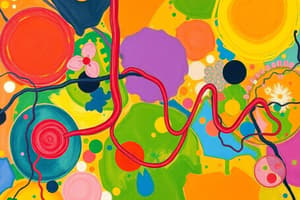Podcast
Questions and Answers
When a compound donates (loses) electrons, that compound becomes _____
When a compound donates (loses) electrons, that compound becomes _____
oxidized
When a compound accepts (gains) electrons, that compound becomes _____
When a compound accepts (gains) electrons, that compound becomes _____
reduced
In glycolysis, the carbon-containing compound that functions as the electron donor is _____
In glycolysis, the carbon-containing compound that functions as the electron donor is _____
glucose
Once the electron donor in glycolysis gives up its electrons, it is oxidized to a compound called _____
Once the electron donor in glycolysis gives up its electrons, it is oxidized to a compound called _____
_____ is the compound that functions as the electron acceptor in glycolysis.
_____ is the compound that functions as the electron acceptor in glycolysis.
The reduced form of the electron acceptor in glycolysis is _____
The reduced form of the electron acceptor in glycolysis is _____
Which compounds among the products of glycolysis contain energy that can be used by other biological reactions?
Which compounds among the products of glycolysis contain energy that can be used by other biological reactions?
What is the direct role of O2 in mitochondrial electron transport?
What is the direct role of O2 in mitochondrial electron transport?
How would anaerobic conditions affect the rate of electron transport and ATP production during oxidative phosphorylation?
How would anaerobic conditions affect the rate of electron transport and ATP production during oxidative phosphorylation?
What is the term for metabolic pathways that release stored energy by breaking down complex molecules?
What is the term for metabolic pathways that release stored energy by breaking down complex molecules?
The glucose molecule has a large quantity of energy in its _____
The glucose molecule has a large quantity of energy in its _____
Which statement describes the results of the following reaction: C6H12O6 + 6 O2 → 6 CO2 + 6 H2O + Energy?
Which statement describes the results of the following reaction: C6H12O6 + 6 O2 → 6 CO2 + 6 H2O + Energy?
In glycolysis, how many NADH are produced?
In glycolysis, how many NADH are produced?
In glycolysis, what starts the process of glucose oxidation?
In glycolysis, what starts the process of glucose oxidation?
Which of these is NOT a product of glycolysis?
Which of these is NOT a product of glycolysis?
How many oxygen molecules (O2) are required each time a molecule of glucose (C6H12O6) is completely oxidized?
How many oxygen molecules (O2) are required each time a molecule of glucose (C6H12O6) is completely oxidized?
What is the major adaptive advantage of cellular respiration?
What is the major adaptive advantage of cellular respiration?
The four stages of cellular respiration function independently.
The four stages of cellular respiration function independently.
What happens to the cell's rate of glucose utilization when ATP demand exceeds ATP supply under anaerobic conditions?
What happens to the cell's rate of glucose utilization when ATP demand exceeds ATP supply under anaerobic conditions?
In muscle cells, what does fermentation produce?
In muscle cells, what does fermentation produce?
Which of the following correctly pairs the process with its inputs and outputs?
Which of the following correctly pairs the process with its inputs and outputs?
In cellular respiration, most ATP molecules are produced by _____
In cellular respiration, most ATP molecules are produced by _____
What is the final electron acceptor of cellular respiration?
What is the final electron acceptor of cellular respiration?
During electron transport, energy from _____ is used to pump hydrogen ions into the _____
During electron transport, energy from _____ is used to pump hydrogen ions into the _____
Flashcards are hidden until you start studying
Study Notes
Cellular Respiration Overview
- Cellular respiration converts energy in food to ATP through a series of reactions.
- Electrons are transferred between electron donors and acceptors in oxidation-reduction (redox) reactions.
Glycolysis
- Glycolysis occurs in the cytoplasm and breaks down glucose into pyruvate.
- Glucose serves as the electron donor and is oxidized to pyruvate.
- NAD+ acts as the electron acceptor, becoming reduced to NADH.
- ATP is produced through substrate-level phosphorylation, where a phosphate group is added directly to ADP.
Products of Glycolysis
- Key products include pyruvate, ATP, and NADH, which can be utilized in subsequent biological reactions.
- The net gain from glycolysis per glucose is 2 ATP molecules.
Acetyl CoA Formation and Citric Acid Cycle
- Pyruvate is oxidized to Acetyl CoA, releasing CO2.
- The citric acid cycle involves a complex pathway breaking down Acetyl CoA into CO2, generating ATP, NADH, and FADH2.
Electron Transport Chain (ETC)
- O2 serves as the final electron acceptor, reducing to water.
- ATP production occurs through oxidative phosphorylation.
- Electron carriers NADH and FADH2 donate electrons to the ETC, with NADH producing more ATP than FADH2.
Anaerobic Conditions
- In the absence of oxygen, the ETC halts, and ATP synthesis stops.
- Fermentation allows glycolysis to continue under anaerobic conditions by regenerating NAD+ from NADH, leading to lactate or ethanol production.
Regulation of Cellular Respiration
- ATP levels regulate the rate of cellular respiration via feedback inhibition, particularly affecting phosphofructokinase (PFK) in glycolysis.
- High ATP concentrations inhibit PFK, slowing down ATP production when demand is low.
Metabolic Pathways
- Catabolic pathways release energy by breaking down molecules, while anabolic pathways synthesize complex molecules.
- Glycolysis does not occur within mitochondria, unlike the citric acid cycle and ETC.
Energy Storage and Utilization
- Most energy from glucose oxidation is stored in NADH after glycolysis and the citric acid cycle.
- Glucose oxidation involves breaking C-H bonds in glucose, releasing CO2 and energy.
Key Concepts in Cellular Respiration
- Substrate-level phosphorylation generates ATP in glycolysis and the citric acid cycle.
- The process of ATP synthesis is driven by the proton gradient established during electron transport.
- Fermentation can only partially satisfy energy needs due to low ATP yield compared to aerobic respiration.
Other Significant Points
- Each glucose molecule requires 6 O2 for complete oxidation to CO2 and H2O.
- Chemiosmotic ATP synthesis is a fundamental process in both prokaryotic and eukaryotic cells.
- In muscle cells, lactic acid fermentation occurs during intense activity when oxygen supply cannot meet demand.
- Fermentation pathways yield 2 ATP in energy, showcasing less efficiency than aerobic processes.
Studying That Suits You
Use AI to generate personalized quizzes and flashcards to suit your learning preferences.




